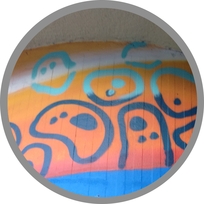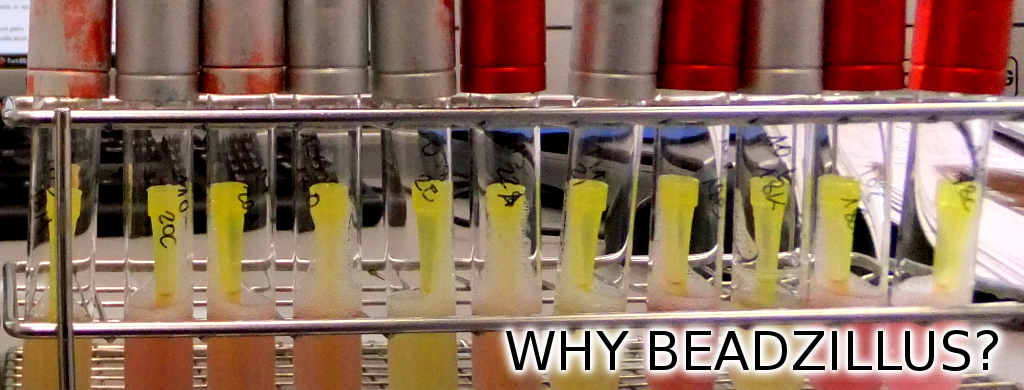Team:LMU-Munich/Why Beadzillus
From 2012.igem.org
| Line 13: | Line 13: | ||
<p align="justify"> | <p align="justify"> | ||
<br> | <br> | ||
| - | The use of filters in every day life as well as in the lab is widespread. There are ''Brita'' filters to filter chalk and other contaminants out of drinking water as well as for showers. In the lab filters are used for DNA purification or protein purification. All of the filters are filled with some matices which determine the function of the filter. To maximize the surface in a miminal volume, beads are commonly applied in any kind of filters. These microbeads have a certain size and can display protein on their surface for functional use of them. Then the feature of the protein characterize the characteristics of the filter. The coupling of proteins to the beads is based on affinity binding, for example nickle NTA-tags where the protein which carrys the histidin tag binds to the nickel ion.Several companies offer such microbeads with proteins coupled to their surface by using affinity tags. | + | The use of filters in every day life as well as in the lab is widespread. There are ''Brita'' filters to filter chalk and other contaminants out of drinking water as well as for showers. In the lab filters are used for DNA purification or protein purification. |
| + | |||
| + | PICTURE | ||
| + | |||
| + | |||
| + | |||
| + | All of the filters are filled with some matices which determine the function of the filter. To maximize the surface in a miminal volume, beads are commonly applied in any kind of filters. These microbeads have a certain size and can display protein on their surface for functional use of them. Then the feature of the protein characterize the characteristics of the filter. The coupling of proteins to the beads is based on affinity binding, for example nickle NTA-tags where the protein which carrys the histidin tag binds to the nickel ion.Several companies offer such microbeads with proteins coupled to their surface by using affinity tags. | ||
<br> | <br> | ||
<br> | <br> | ||
| Line 19: | Line 25: | ||
<br> | <br> | ||
<br> | <br> | ||
| - | But what are these biological beads made of? Based on a clever thing, evolution | + | But what are these biological beads made of? Based on a clever thing, evolution developed millions of years ago endospores of the soil bacteria ''Bacillus subtilis''. They are a dormant life stage of this bacteria which is highly resistant and can survive harsh conditions. To get to know more about the life cycle and the production of endospores have a look at the life cycle of B. subtilis on the next page. |
| - | + | ||
| - | + | ||
</p> | </p> | ||
Revision as of 11:40, 25 October 2012

The LMU-Munich team is exuberantly happy about the great success at the World Championship Jamboree in Boston. Our project Beadzillus finished 4th and won the prize for the "Best Wiki" (with Slovenia) and "Best New Application Project".
[ more news ]


Why Beadzillus?
The use of filters in every day life as well as in the lab is widespread. There are Brita filters to filter chalk and other contaminants out of drinking water as well as for showers. In the lab filters are used for DNA purification or protein purification.
PICTURE
All of the filters are filled with some matices which determine the function of the filter. To maximize the surface in a miminal volume, beads are commonly applied in any kind of filters. These microbeads have a certain size and can display protein on their surface for functional use of them. Then the feature of the protein characterize the characteristics of the filter. The coupling of proteins to the beads is based on affinity binding, for example nickle NTA-tags where the protein which carrys the histidin tag binds to the nickel ion.Several companies offer such microbeads with proteins coupled to their surface by using affinity tags.
These beads are usually very expensive, the production is more labourious as the protein has to be expressed, bound to the beads and then washed again, and the binding of the protein is non-covalent. For this problem, we want to offer a synthetic biology solution in our project BEADzillus where we produced biological beads.
But what are these biological beads made of? Based on a clever thing, evolution developed millions of years ago endospores of the soil bacteria Bacillus subtilis. They are a dormant life stage of this bacteria which is highly resistant and can survive harsh conditions. To get to know more about the life cycle and the production of endospores have a look at the life cycle of B. subtilis on the next page.
 "
"








